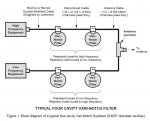902
Member
Greetings all,
I was given a Wacom WP-641 4 can VHF duplexer, but the catch is that there were no cables with it. I made RG-214 jumpers for another project and used them, but I'm having difficulty getting the duplexer to work in the system without severe desense. I suspect two issues - first, a critical cable length between the transmitter and the cavity, and second, the lengths of cable between the UHF T connectors isn't quite right.
For the first issue, I'm going to have to go out and buy a Z matcher or dig out a circulator. But for the second, I need to make new cables. Except Wacom is no more.
Anyone got the formula for these? I'm trying to get into the lower range of the 2 meter ham band and somewhat above/below - but close to - the 2 meter range.
Thank you!
I was given a Wacom WP-641 4 can VHF duplexer, but the catch is that there were no cables with it. I made RG-214 jumpers for another project and used them, but I'm having difficulty getting the duplexer to work in the system without severe desense. I suspect two issues - first, a critical cable length between the transmitter and the cavity, and second, the lengths of cable between the UHF T connectors isn't quite right.
For the first issue, I'm going to have to go out and buy a Z matcher or dig out a circulator. But for the second, I need to make new cables. Except Wacom is no more.
Anyone got the formula for these? I'm trying to get into the lower range of the 2 meter ham band and somewhat above/below - but close to - the 2 meter range.
Thank you!


